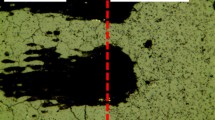Abstract
As an important optical component in laser system, silicon mirror surface is required to have micron-level flatness and subnanometer-level roughness. The research concentrates on how to improve roughness as far as possible while maintaining flatness of silicon mirror surface during chemical mechanical polishing (CMP) process. A polishing edge effect model is established to explain the reason of flatness deterioration, and a roughness theoretical model is set up to get the limit of perfect surface roughness. Based on the models above, a polishing device is designed to maintain the surface flatness, and the optimized polishing process parameters are obtained by orthogonal tests to get a near-perfect surface roughness. Finally the maintenance of flatness and the improvement of roughness can be achieved at the same time in one step of CMP process. This work can be a guide for silicon mirror manufacture to improve optical reflection performance significantly.
Similar content being viewed by others
Refferences
Srinivasa-Murthy C, Wang D, Beaudoin S P, et al. Stress distribution in chemical mechanical polishing. Thin Solid Films, 1997, 308–309: 533–537
Wang D. Von mises stress in chemical-mechanical polishing processes. J Electrochem Soc, 1997, 144: 1121–1127
Byrne G, Mullany B, Young P. The effect of pad wear on the chemical mechanical polishing of silicon wafers. CIRP Ann-Manuf Tech, 1999, 48: 143–146
Fu G, Chandra A. A model for wafer scale variation ofremoval rate in chemical mechanical polishing based on elastic pad deformation. J Elec Materi, 2001, 30: 400–408
Fu G, Chandra A. A model for wafer scale variation of material removal rate in chemical mechanical polishing based on viscoelastic pad deformation. J Elec Materi, 2002, 31: 1066–1073
Li J, Wei Z, Wang T, et al. A theoretical model incorporating both the nano-scale material removal and wafer global uniformity during planarization process. Thin Solid Films, 2017, 636: 240–246
Bae J, Lee H, Lee S, et al. Effect of retainer pressure on removal profile and stress distribution in oxide CMP. In: Proceedings of International Conference on Planarizaiton/CMP Technology. Fukuoka, 2009. 345–349
Chen K S, Yeh H M, Yan J L, et al. Finite-element analysis on wafer-level CMP contact stress: Reinvestigated issues and the effects of selected process parameters. Int J Adv Manuf Tech, 2009, 42: 1118–1130
Lin Y Y, Chen D Y, Ma C. Simulations of a stress and contact model in a chemical mechanical polishing process. Thin Solid Films, 2009, 517: 6027–6033
Park Y, Jeong H, Choi S, et al. Planarization of wafer edge profile in chemical mechanical polishing. Int J Precis Eng Manuf, 2013, 14: 11–15
Fujita T, Watanabe J. Surface conformable polishing mechanism for chemical mechanical polishing. J Electrochem Soc, 2009, 156: H479
Fujita T, Watanabe J. Pressure distribution control on surface conformable polishing in chemical mechanical planarization. ECS J Solid State Sci Tech, 2015, 4: P5008–P5015
Fujita T, Watanabe J. Fine adjustment of pressure distribution on surface conformable polishing in chemical mechanical planarization. ECS J Solid State Sci Tech, 2017, 6: P462–P469
Suni T, Henttinen K, Suni I, et al. Effects of plasma activation on hydrophilic bonding of Si and SiO2. J Electrochem Soc, 2002, 149: G348
Liu Y, Zhang K, Wang F, et al. Investigation on the final polishing slurry and technique of silicon substrate in ULSI. MicroElectron Eng, 2003, 66: 438–444
**e Y, Bhushan B. Effects of particle size, polishing pad and contact pressure in free abrasive polishing. Wear, 1996, 200: 281–295
Xu J, Luo J B, Wang L L, et al. The crystallographic change in subsurface layer of the silicon single crystal polished by chemical mechanical polishing. Tribol Int, 2007, 40: 285–289
Si L, Guo D, Luo J, et al. Monoatomic layer removal mechanism in chemical mechanical polishing process: A molecular dynamics study. J Appl Phys, 2010, 107: 064310
Zarudi I, Han B S. Deformation and material removal rate in polishing silicon wafers. J Mater Processing Tech, 2003, 140: 641–645
Michel B, Giza M, Krumrey M, et al. Effects of dielectric barrier discharges on silicon surfaces: Surface roughness, cleaning, and oxidation. J Appl Phys, 2009, 105: 073302
Yu J, Namba Y. Atomic surface roughness. Appl Phys Lett, 1998, 73: 3607–3609
Li J, Liu Y H, Dai Y J, et al. Achievement of a near-perfect smooth silicon surface. Sci China Tech Sci, 2013, 56: 2847–2853
Howland R, Benatar L. A Practical Guide to Scanning Probe Microscopy. Santa Clara: Park Scientific Instruments, 1996
Pei Z J, Strasbaugh A. Fine grinding of silicon wafers: Designed experiments. Int J Machine Tools Manufacture, 2002, 42: 395–404
Author information
Authors and Affiliations
Corresponding authors
Additional information
This work was supported by the National Basic Research Program of China (Grant No. 2015CB057203), and the National Natural Science Foundation of China (Grant No. 91323302). This work was carried out in Tsinghua University and Hwatsing Technology Co., Ltd, China.
Rights and permissions
About this article
Cite this article
Jiang, B., Zhao, D., Wang, B. et al. Flatness maintenance and roughness reduction of silicon mirror in chemical mechanical polishing process. Sci. China Technol. Sci. 63, 166–172 (2020). https://doi.org/10.1007/s11431-018-9414-6
Received:
Accepted:
Published:
Issue Date:
DOI: https://doi.org/10.1007/s11431-018-9414-6




